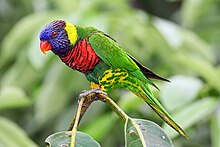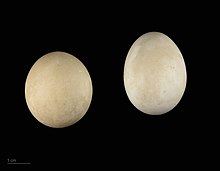| Coconut lorikeet | |
|---|---|

| |
| At Jurong Bird Park, Singapore | |
| Conservation status | |
 Least Concern (IUCN 3.1) | |
| Scientific classification | |
| Domain: | Eukaryota |
| Kingdom: | Animalia |
| Phylum: | Chordata |
| Class: | Aves |
| Order: | Psittaciformes |
| Family: | Psittaculidae |
| Genus: | Trichoglossus |
| Species: | T. haematodus |
| Binomial name | |
| Trichoglossus haematodus (Linnaeus, 1771) | |
The coconut lorikeet (Trichoglossus haematodus), also known as the green-naped lorikeet, is a parrot in the family Psittaculidae. Seven species of lorikeets now recognised were once lumped together under Trichoglossus haematodus.
Taxonomy
In 1758, English naturalist George Edwards described this species as the red-breasted parrakeet in his work Gleanings of Natural History. He had obtained a stuffed specimen from a China warehouse in London, that had come from the East Indies. "It is a parrakeet, equal to any I have seen for beauty; and I believe hath never been described or figured until now." In 1760 the French zoologist Mathurin Jacques Brisson included a description of the coconut lorikeet in his Ornithologie based on a specimen collected on the island of Ambon in Indonesia. He used the French name La perruche variée d'Amboine and the Latin name Psittaca amboinensis varia. Although Brisson coined Latin names, these do not conform to the binomial system and are not recognised by the International Commission on Zoological Nomenclature.
Acknowledging both previous authors as having written about the same species, Carl Linnaeus formally described the coconut lorikeet in 1771 as Psittacus haematod.(us). He had abbreviated the name to avoid it spilling over onto the next line. The shortened form was followed for many years. The specific epithet is from the Ancient Greek haimatōdēs for "blood-red". Hence the translation of its binomial name is "bloody hair-tongue".
For many years, the species was broadly defined with 20 or 22 subspecies recognised, and was known as the rainbow lorikeet. This name has been reapplied to eastern Australian populations, now classified as a distinct species Trichoglossus moluccanus. Also recognised as distinct species are the sunset lorikeet (T. forsteni), leaf lorikeet (T. weberi), marigold lorikeet (T. capistratus), red-collared lorikeet (T. rubritorquis), and Biak lorikeet (T. rosenbergii).
Six subspecies are recognised:
"Coconut lorikeet" has been designated as the official common name for the species by the International Ornithologists' Union (IOC).
Description
The coconut lorikeet measures 25–30 cm (10–12 in) in length and weighs around 109–137 g (3.8–4.8 oz). The bill is orange-red, and the head dark blue fading to brown at the neck. It has a yellow collar and green upperparts. The breast is red with blue-black barring, and the belly is green with yellow barring. The tail is green above and barred in green and yellow below. The male's iris is bright red, while in the female it is orange-red.
Distribution and habitat
Trichoglossus haematodus is found in eastern Indonesia, on Buru, Seram, Misool, Waigeo, Numfoor, Yapen and the Aru Islands, in Indonesia and Papua New Guinea on New Guinea, in the Bismarck Archipelago, the Solomon Islands, Vanuatu and New Caledonia.
The species occupies a wide range of lowland and wooded hill habitats, including mangroves, rainforest, nypa forest, swamps, savanna and woodland. It also occupies human-modified areas including coconut plantations, gardens, agricultural land and disturbed forest. It is found from sea level up to as high as 2,440 m (8,010 ft); this upper altitude level varies by location.
Biology

These lorikeets have on the tip of their specialized tongue a small brush, which is actually the tongue's extended papillae. With the help of the tongue, they are able to feed on nectar and pollen from flowers. They mainly feed on nectar and pollen, but they also eat other parts of the flowers, as well as seeds, fruits, berries, insects, and larvae. They usually make a huge noise during flight, emitting screeching calls (e.g. “peaow-peaow-peaow”), at regular intervals.
Coconut lorikeets are monogamous birds, choosing only one partner for their whole life. They are diurnal birds living in very large bands. In the evening, they join their fellows in a dormitory tree. These birds may breed throughout most of year, depending on the region. Usually they breed in the spring, from July to December. They usually raise one brood a year, sometimes two.
Nests are usually located in holes in decaying wood, such as hollows of eucalyptus trees, at a height of 25 metres (82 ft) above the ground. Females lay two matte white, round eggs and incubate them for 23–25 days. Parents feed the chicks for 7–8 weeks, after which they leave the nest and after another 2–3 weeks they become completely independent.
Gallery
References
- ^ BirdLife International (2018). "Trichoglossus haematodus". IUCN Red List of Threatened Species. 2018: e.T22725310A132177469. doi:10.2305/IUCN.UK.2018-2.RLTS.T22725310A132177469.en. Retrieved 25 September 2021.
- Edwards, George (1758). Gleanings of Natural History. Vol. 1. London: Printed for author at the Royal College of Physicians. pp. 45–46.
- Brisson, Mathurin Jacques (1760). Ornithologie, ou, Méthode contenant la division des oiseaux en ordres, sections, genres, especes & leurs variétés (in French and Latin). Vol. 4. Paris: Jean-Baptiste Bauche. pp. 364–66. The two stars (**) at the start of the section indicates that Brisson based his description on the examination of a specimen.
- Allen, J.A. (1910). "Collation of Brisson's genera of birds with those of Linnaeus". Bulletin of the American Museum of Natural History. 28: 317–35. hdl:2246/678.
- Linnaeus, Carl (1771). Mantissa Plantarum. Stockholm: Laurentii Salvii. p. 524.
- Jobling, James A. (2010). The Helm Dictionary of Scientific Bird Names. London: Christopher Helm. p. 184. ISBN 978-1-4081-2501-4.
- Gray, Jeannie; Fraser, Ian (2013). Australian Bird Names: A Complete Guide. Collingwood, Victoria: Csiro Publishing. p. 133. ISBN 978-0-643-10471-6.
- ^ Braun, Michael P.; Reinschmidt, Matthias; Datzmann, Thomas; Waugh, David; Zamora, Rafael; Häbich, Annett; Neves, Luís; Gerlach, Helga; Arndt, Thomas; Mettke-Hofmann, Claudia; Sauer-Gürth, Hedwig; Wink, Michael (2017). "Influences of oceanic islands and the Pleistocene on the biogeography and evolution of two groups of Australasian parrots (Aves: Psittaciformes: Eclectus roratus, Trichoglossus haematodus complex). Rapid evolution and implications for taxonomy and conservation". European Journal of Ecology. 3 (2): 47–66. doi:10.1515/eje-2017-0014.
- ^ Gill, Frank; Donsker, David, eds. (2019). "Parrots, cockatoos". World Bird List Version 9.1. International Ornithologists' Union. Retrieved 19 February 2019.
- ^ Collar, N.; Christie, D.; Kirwan, G. M. (2019). del Hoyo, Josep; Elliott, Andrew; Sargatal, Jordi; Christie, David A; de Juana, Eduardo (eds.). "Coconut Lorikeet (Trichoglossus haematodus)". Handbook of the Birds of the World Alive. Barcelona: Lynx Edicions. Retrieved 21 February 2019.
- "Trichoglossus haematodus range map". International Union for Conservation of Nature and Natural Resources. Retrieved 2015-01-04.
- ^ Ananda Porto, Terra da Gente Periquito-arco-íris tem língua adaptada para se alimentar de nectar(in Portuguese)
- Gordon Beruldsen, Australian Birds, their Nests and Eggs, Kenmore Hills, G. Beruldsen, 2003, 424 p. (ISBN 0-646-42798-9), p. 245
| Taxon identifiers | |
|---|---|
| Trichoglossus haematodus |
|
| Psittacus haematodus | |




